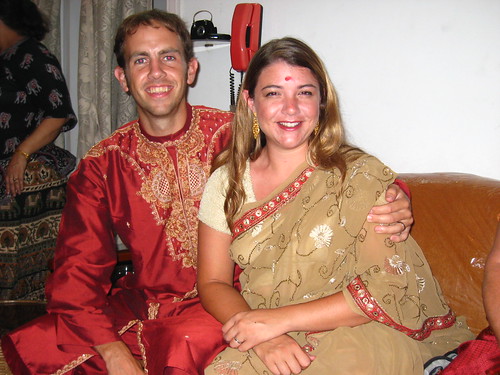Alright, this is the last of the 3 posts about food you must try when visiting India. The first post covered our travels in the north, through Rajastan, Mumbai, Gujarat and Goa. The second post was dedacated to that amazing city of Kochi and focused on the resturant, Dal Roti. I have been assured by the owner Ramesh that the recipes I promised in that post would be up on his blog soon.
Below are my greatest hits from Chennai and Calcutta. Forgive me if I ramble on since I am Thailand now and am suffering from major Indian food withdrawl.
Mutton Kola Curry - I ate this curry for three straigt days in Chennai. It consisted of succlent tender minced lamb meat balls either served dry or in a curry gravy. The fiery gravy was thick with tomato and ground onion, as are most Indian gravies. The major differendce here was an even more libreal use of aromatics in the form of multiple eidble fresh curry leaves, cinnamon, cloves, and many other spices I could not identify. This is the best recipe I could find, but I am not sure if it will produce what we had. If anyone knows of a better one, please let me know! We washed the curry down with frech pineapple shakes and sopped it up with buttery parathas. Ponnusamay Hotel, Chennai
Ayurvedic Vegatarian Meal - This venerated Chennai establishment is also an ayurvedic center. They are a pure veg resturant (no eggs, meat, but dairy OK) that offer a special 26 course lunch. Each dish is to be eaten in a specific order. It started with 5 juices - date nut, beet, buttermilk, branwater, and I think banana. Next was the 4 raw vegatable salads, then 4 partially cooked salads, followed by 4 fully cooked dishes. This was all followed by 2 types of rice, 3 types of sambar (a falvorful lentil gravy ubiqutuois in South Indian meals), fianlyl a dessert of honey and payasam, a sweet. The most memorable vegatables was the banana flower salad. Only after this meal is finished is one to deink water, as this is thought to impair digestion. Not only did I not miss meat during meal, I felt better than ever. Of course, our dinner was Mutton Kola Curry. Sanjeevanam Vegatarian Health Restaurant, Chennai
Bengali Sweets - So Ian has already wrote a bit on the city-wide addiction of Bengalis to sweets in his previous blog. It is all true. There were times this Durga Puja season that we would eat Rasgullas for breakfast, lunch, and dinner. Not entirely by choice of course. How can you resist my Aunt Mya chasing you around with a clay pot full of them? Ian could not.
Most foodies are familiar with the Gulab Jamun, which is a deep fried, sugar water soaked ball of flour and milk solids. This is just the beginning. The king of all Indian sweets, the rassogolla or rusgulla, is a made from milk solids as well. It is not fried, but rather soaked in a warm rose water and sugar mixture. The sweet is usualy served cold or room temperature. These can be modified to include a small cane sugar ball in the core to increase the sweetness. I have seen them as large as a baseball, but normally they are 1 - 1.5 inches in diameter. The perfect rassogolla has a soft texture, a delicate rose taste, and should not be overpoweringly sweet. Once in Udaipur, I starving for them as I passed a sweet shop. I asked the owner for a rassogolla and was brought a small bowl from the back. While all the patrons watched me eat this sweet, I had to feign enjoyment while chewing this sqeaky ball of metallic tasting sweet cheese. He gave me a canned one and thought I couldn't tell!
I could go on and on about the staggering variety of Bengali sweets. What they can do with milk and sugar baffles me. But I would only mention one more - the ras malai. This is similar to a rassogolla but it is flat and soaked in saffron and cardomen flavored milk. Heavenly! If in Calcutta - try Haldirams or KC Das. Don't try the canned version!
Fish Fry - I'm not sure how this famous Calcutta first escaped me on my prior visits. Serving fish fry is as common as serving fried chicken in the south. It's much tastier though. Bengali fish fry consists of a very thin piece of fish smeared with some sort of spice paste, then breaded and deep fried. Sounds simple, and it's divine. Even Ian, that hater off all things fish, ate is fish fry and liked it.
Strangest food we had: Fermented millet alcohol in Sikkim. Steming water is poured over fermented millet in a large bamboo stein. I wasn't particulary strong, but tasted like the last bottle from our carboy of homemade wine - very yeasty. Only my dad and Ian were able to finish it.
That's all for now. Some of the best food we had was at relatives' and friends' houses, too many to mention. Indian hospitality is second to none. As it was explaned to us by a friend in Calcutta, a visitor in a house is treated like he or she is sent by God, and should be fed as such. And we were. I can't wait to go back to India.
- Nisha
Subscribe to:
Post Comments (Atom)

No comments:
Post a Comment